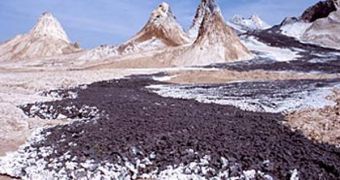The East African Rift, located in the southeastern part of the continent, is one of the most active tectonic regions on Earth, not necessarily in terms of earthquakes, but of the amount of movement that is recorded underneath the Earth's crust. In a few million years, the entire rift will be flooded, and a new sea will appear in Africa. This is the home of the Oldoinyo Lengai volcano, which the locals term the “Mountain of God.” It's the only place on Earth where carbonatites, a kind of lava comprised of more than 30 percent carbon dioxide, comes out of the ground.
What makes this so special is the fact that it's also the only place in the world where the gas does not disintegrate when touching the atmosphere. That is to say, it remains trapped inside the highly viscous form of lava, which has about the same consistency as motor oil. It does not erupt, like other types, at very high temperatures, like, for example, 900 degrees Celsius (1,652 Fahrenheit), as researchers have determined that its average eruption heat reaches only 540 degrees Celsius (1,004 Fahrenheit).
“We now know the origin of one of the most peculiar magmas on Earth. These scientists have found that, based on new studies of the chemistry of gas emissions at Oldoinyo Lengai, a very small amount of melting of Earth's mantle, akin to that beneath mid-ocean ridges, can produce carbonatites,” the National Science Foundation (NSF) Division of Earth Sciences Program Director William Leeman explained for PhysOrg. The NSF was the main source of funding for the recent investigation. Details of the results appear in this week's issue of the scientific journal Nature.
“We were able to collect pristine samples of the volcanic gases because Oldoinyo Lengai was erupting and under tremendous magma pressure at the time. There was minimal air contamination,” the lead author of the journal paper, University of New Mexico Volcanologist Tobias Fischer, added. “The gases reveal that the carbon dioxide comes directly from the upper mantle, just below the East African Rift. These samples of mantle gases allow us to infer the carbon content of the upper mantle where the carbonatites are produced,” Scripps Institution of Oceanography Geochemist David Hilton shared.
“Oldoinyo Lengai magmas also contain an unusually high amount of sodium, up to about 35 percent. It's this sodium content that makes the Lengai carbonatites solid rather than gas at the surface. At all other volcanoes on Earth, carbon dioxide 'degasses' into the atmosphere without forming the sodium-rich carbonatite magmas of Oldoinyo Lengai,” French-based Centre National de la Recherche Scientifique – Centre de Recherches Pe'trographiques et Ge'ochimiques (CNRS-CRPG) Geochemist Pete Burnard concluded.

 14 DAY TRIAL //
14 DAY TRIAL //